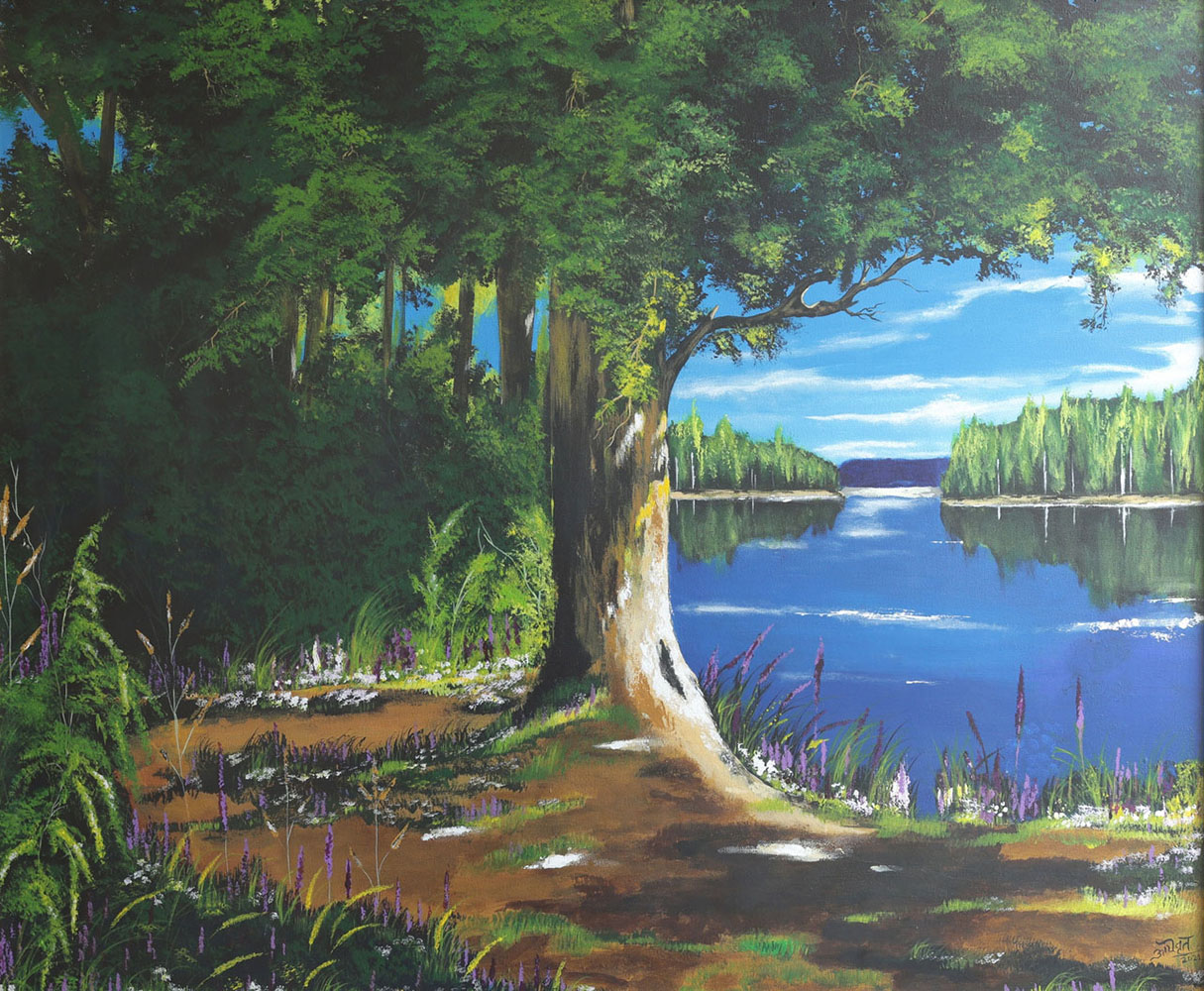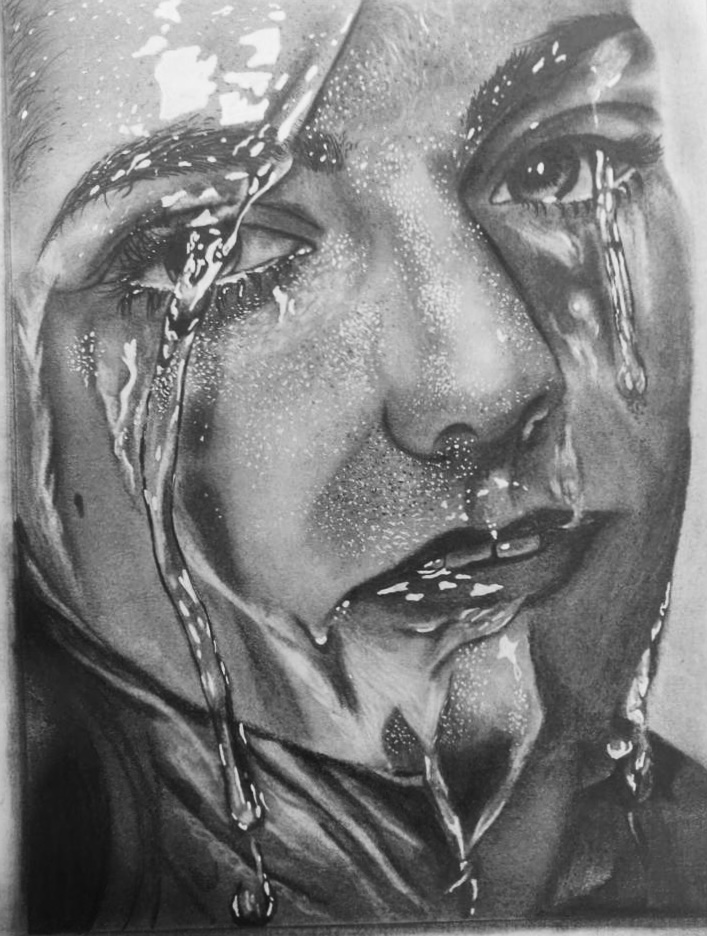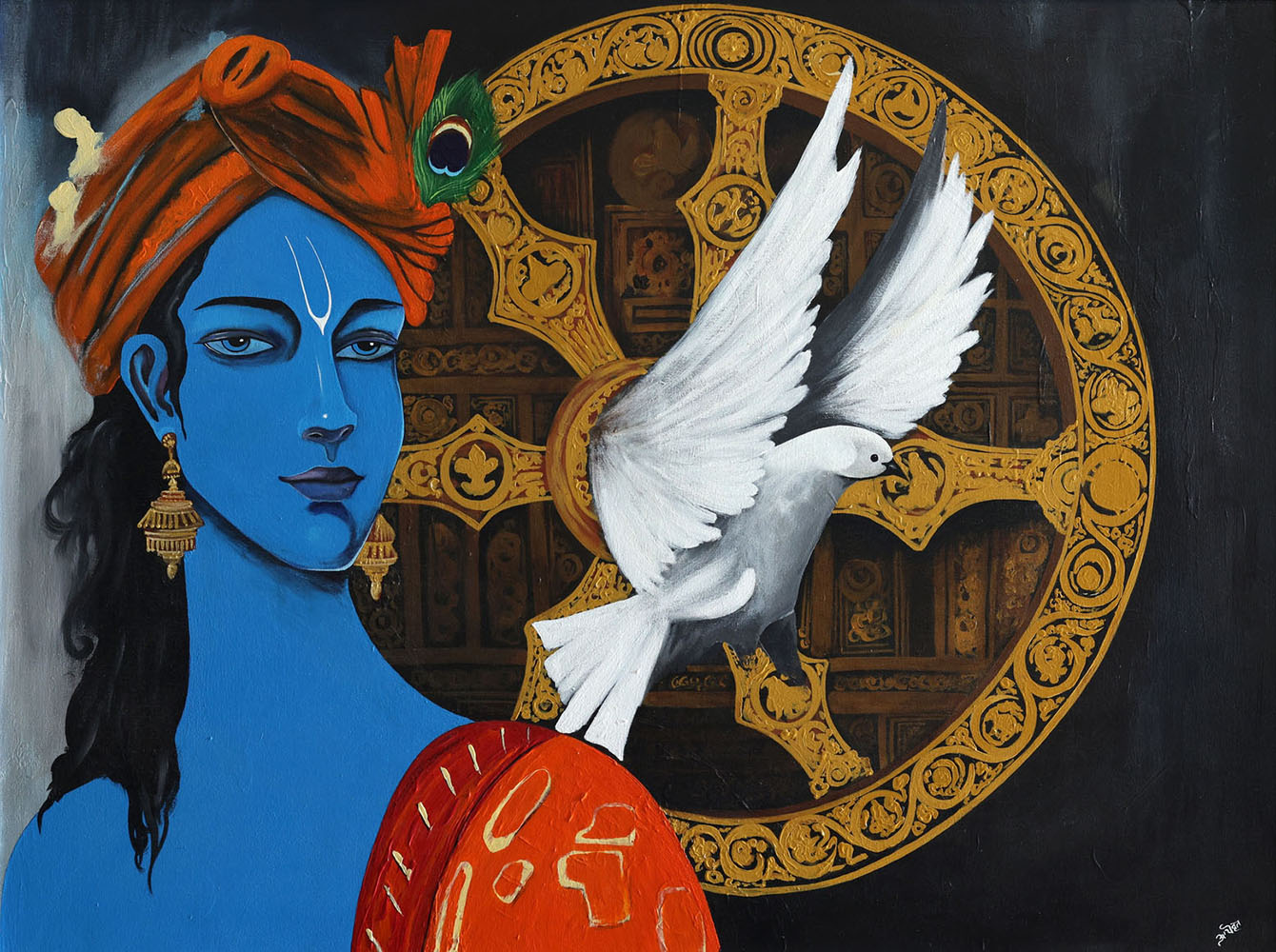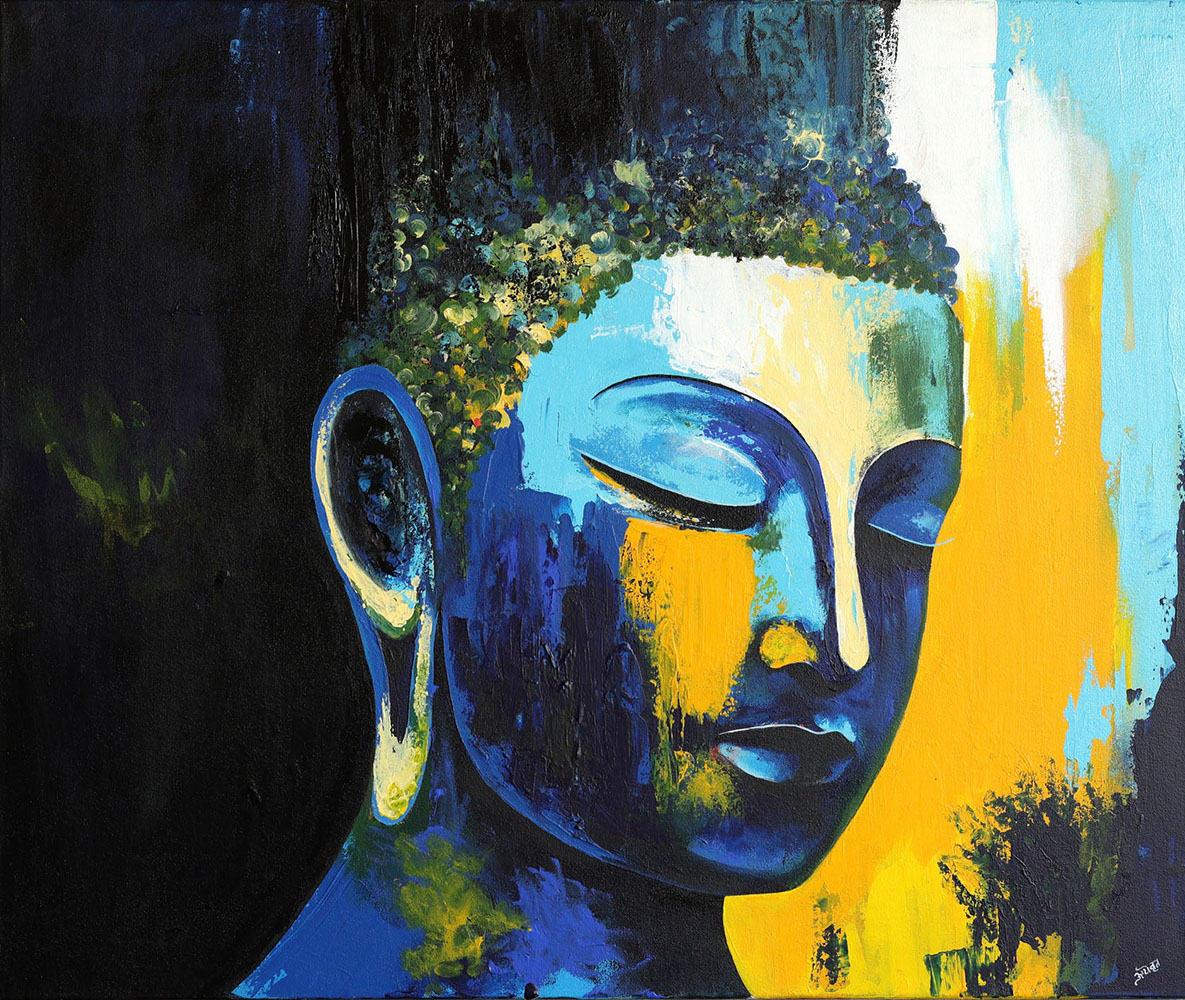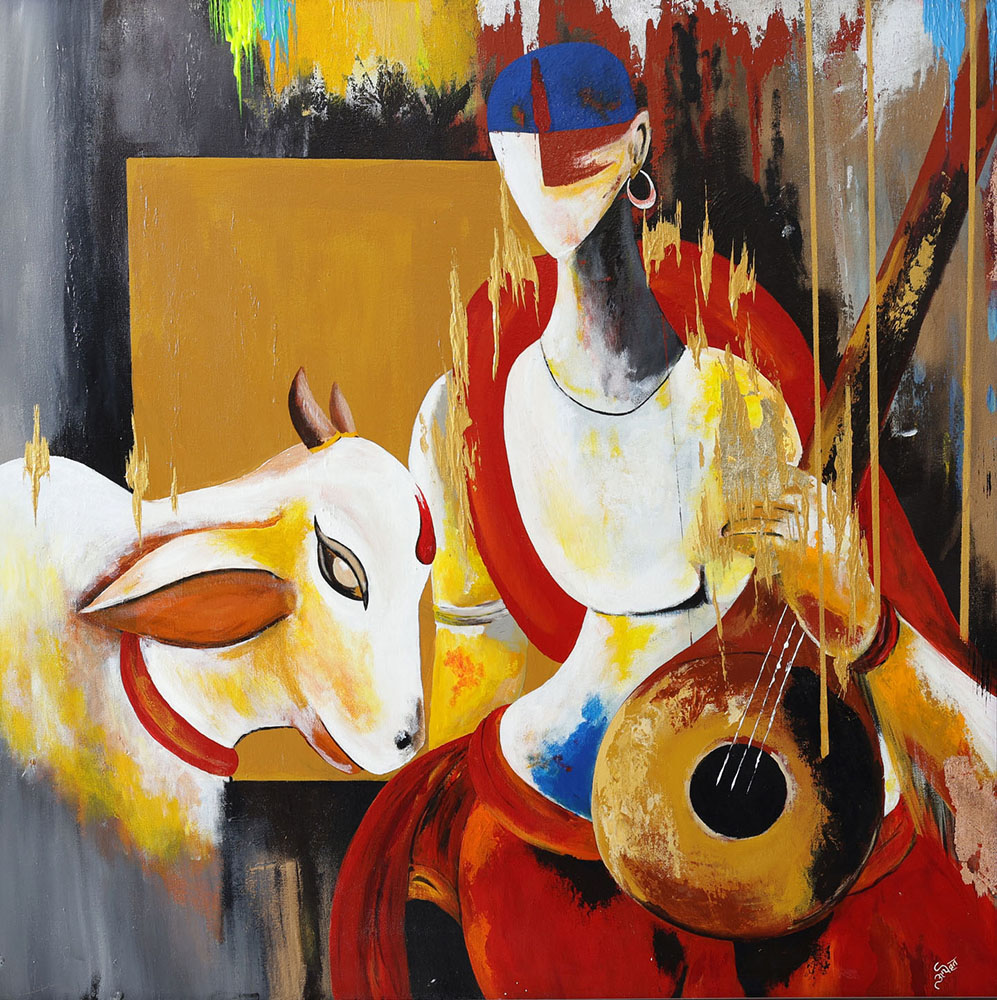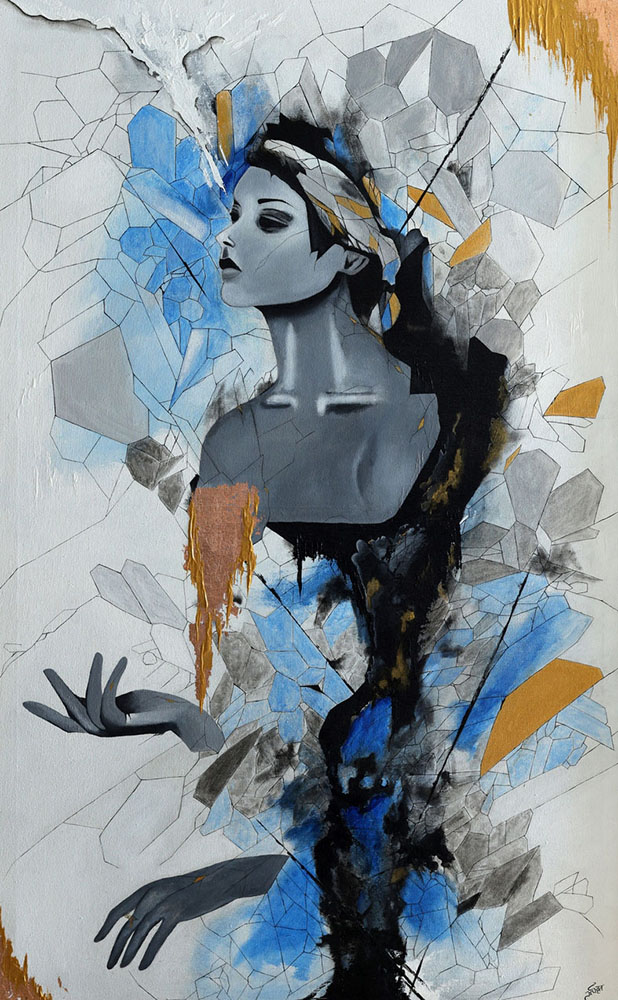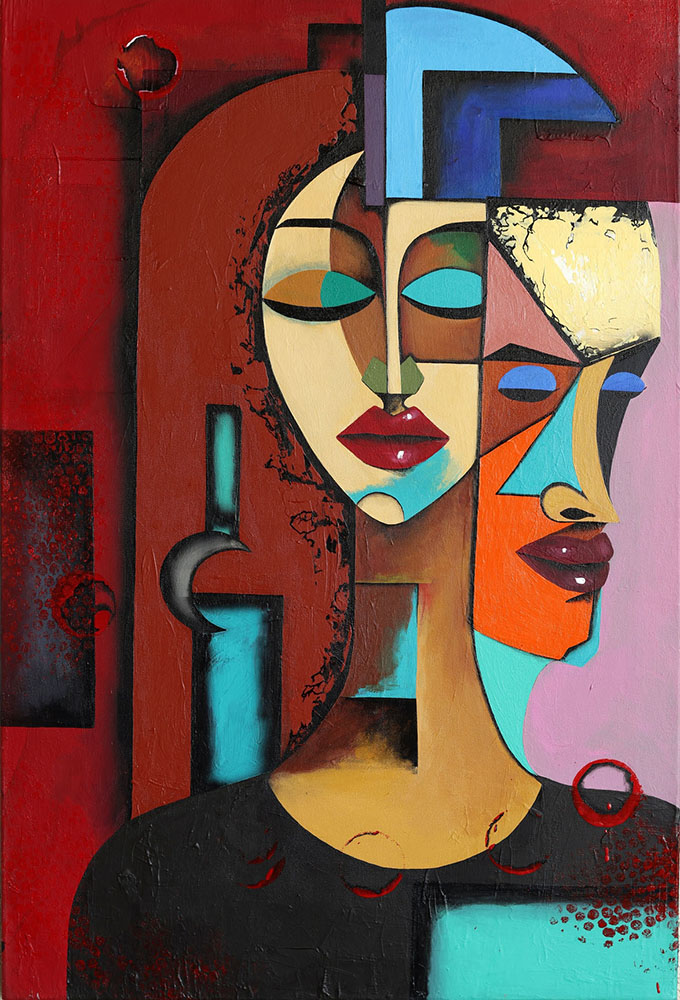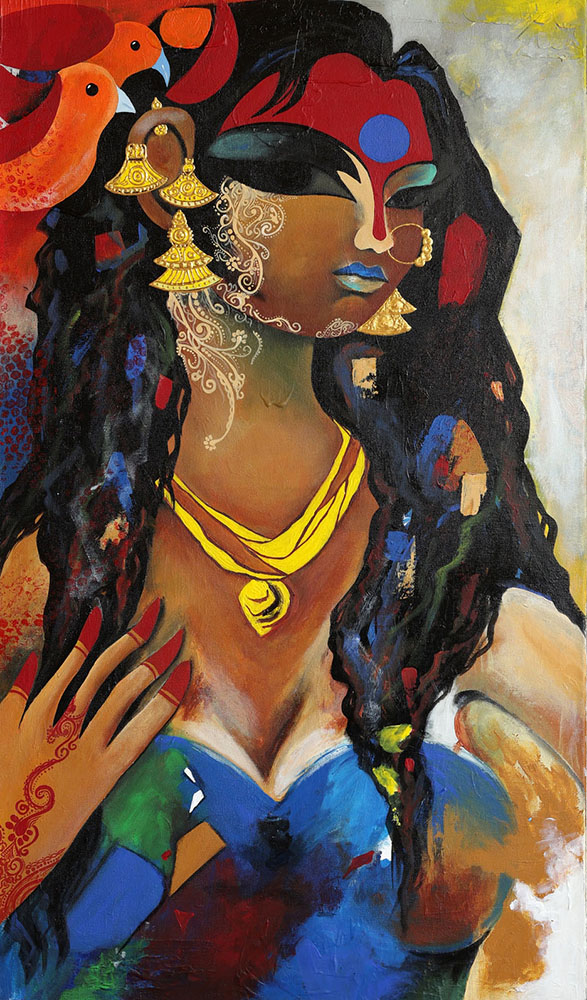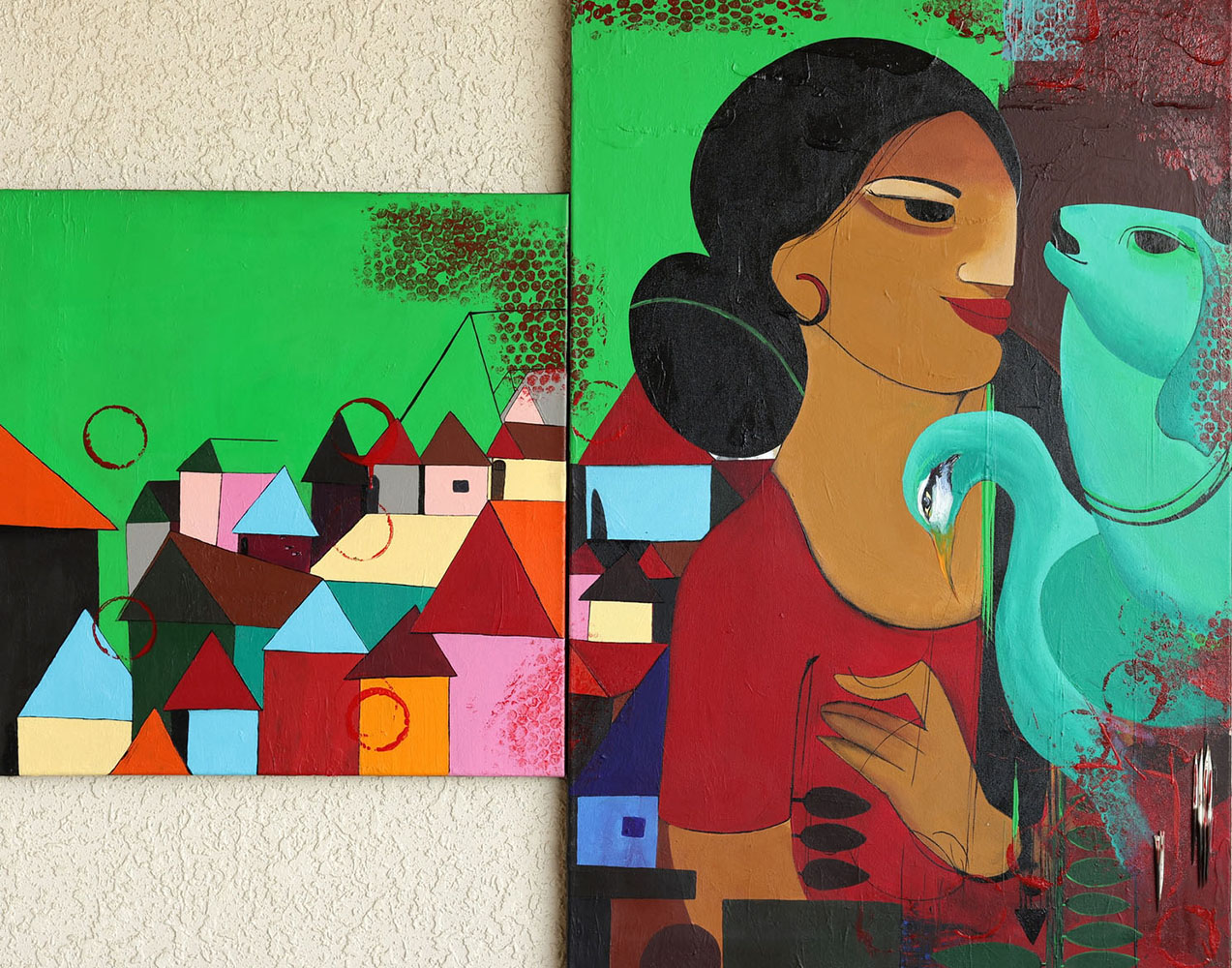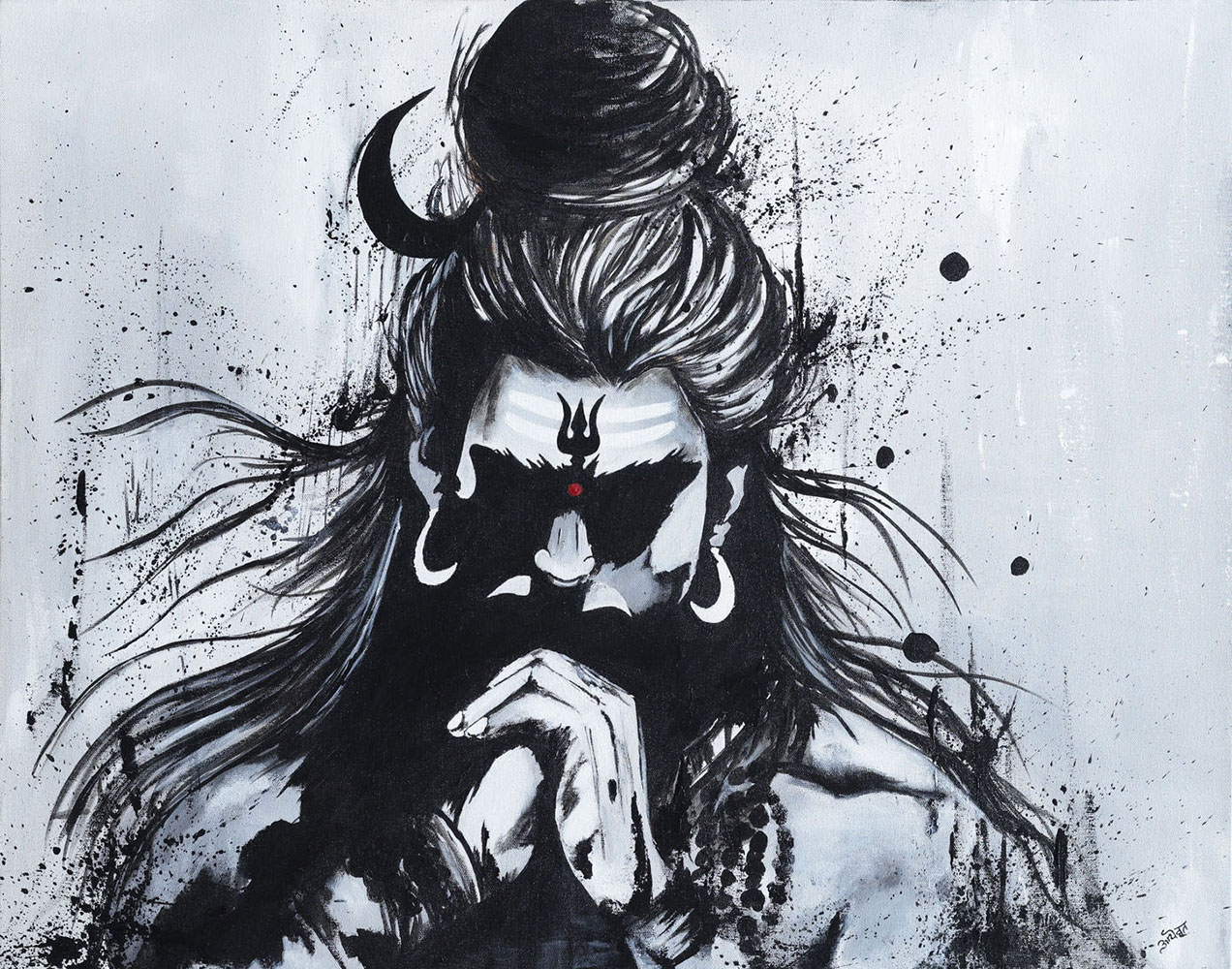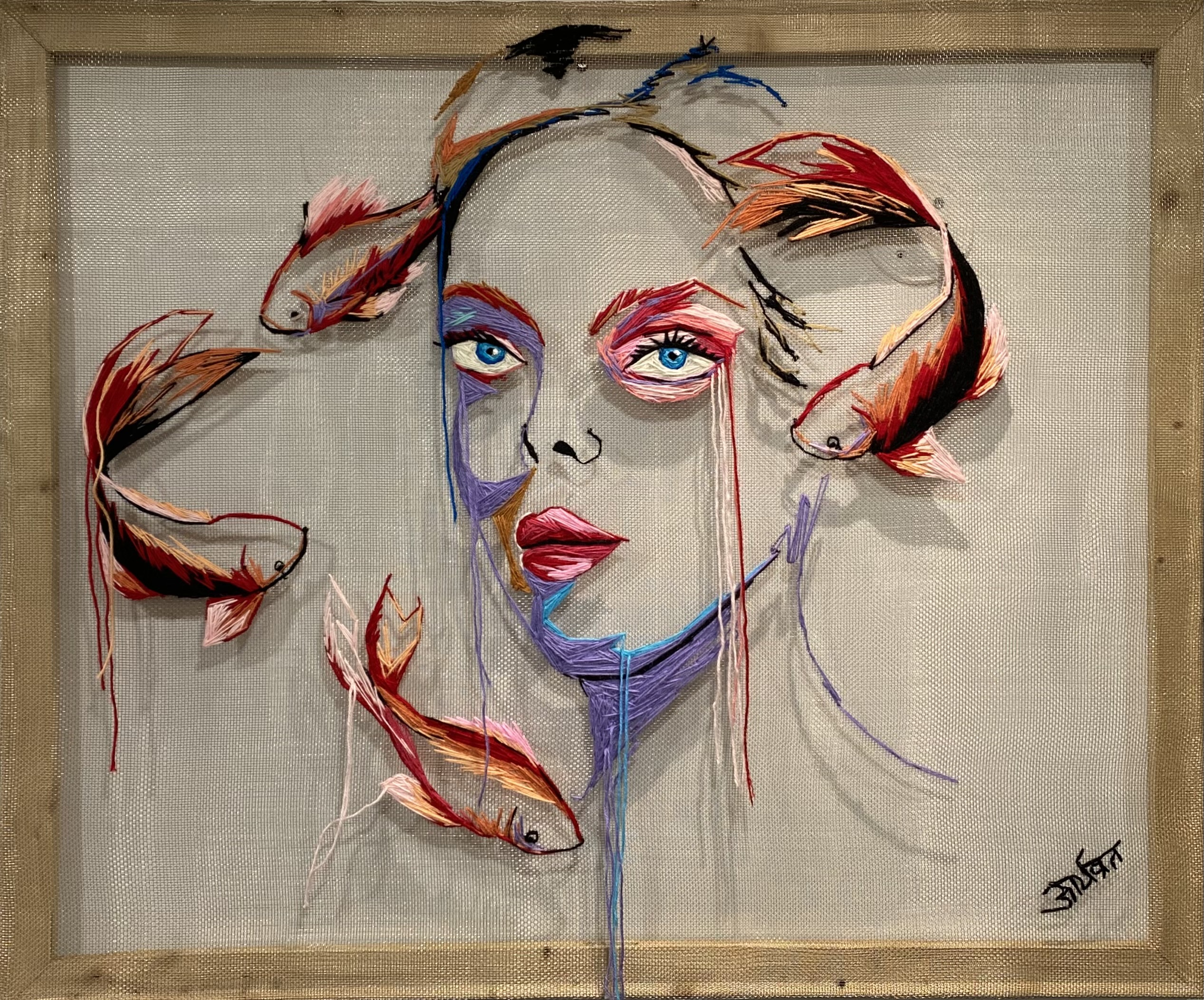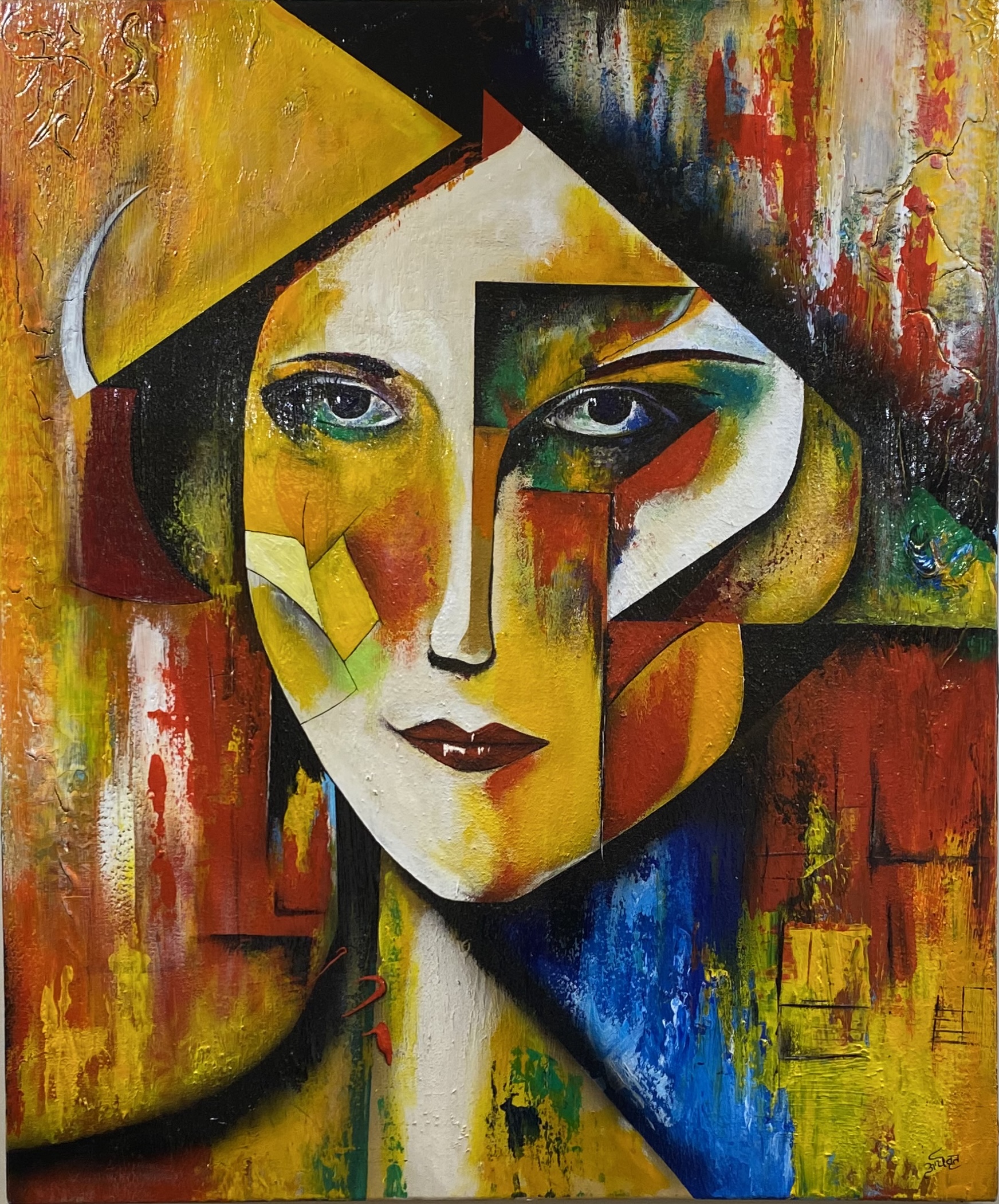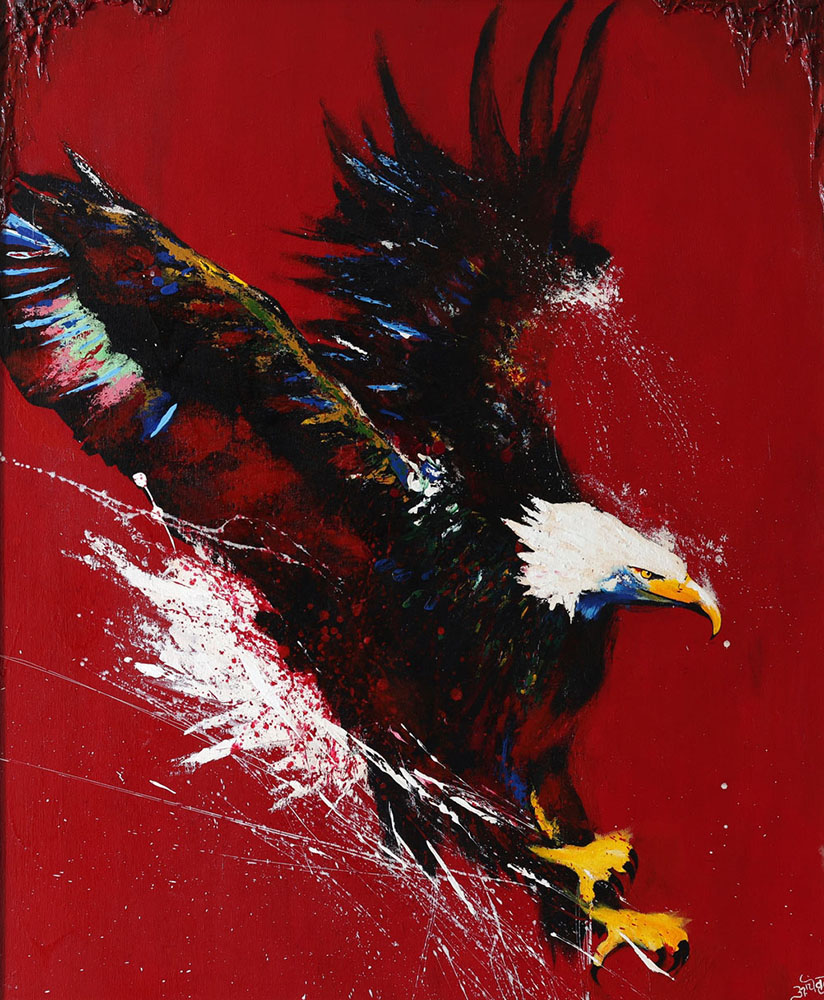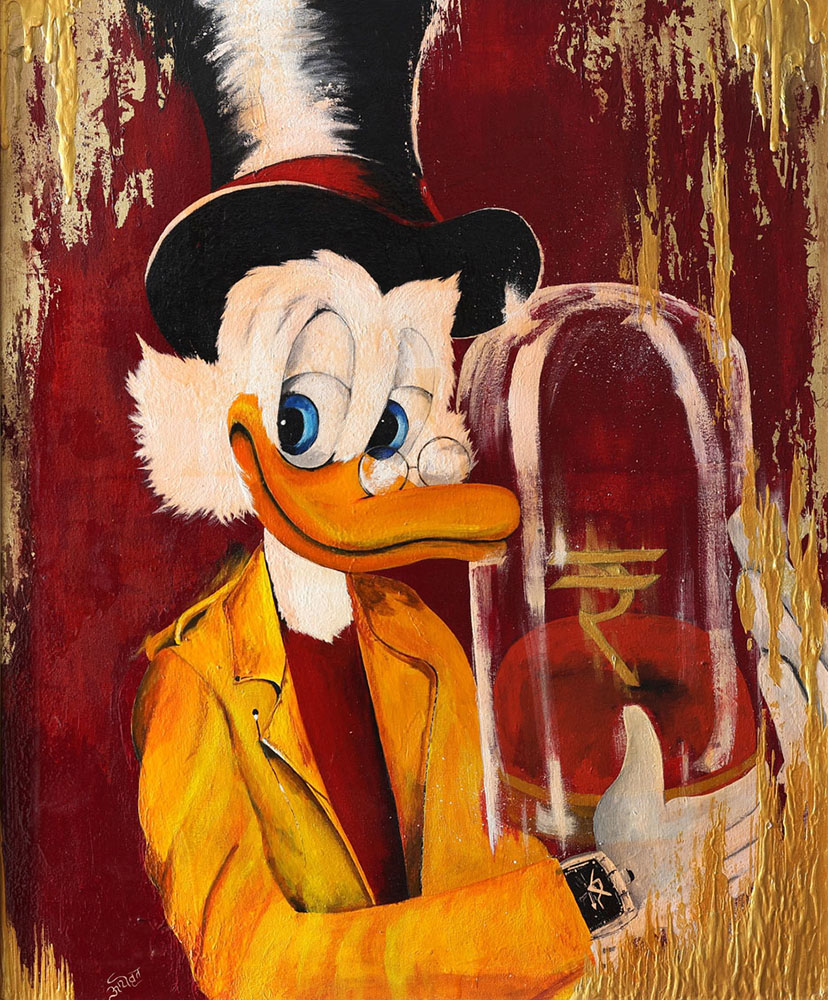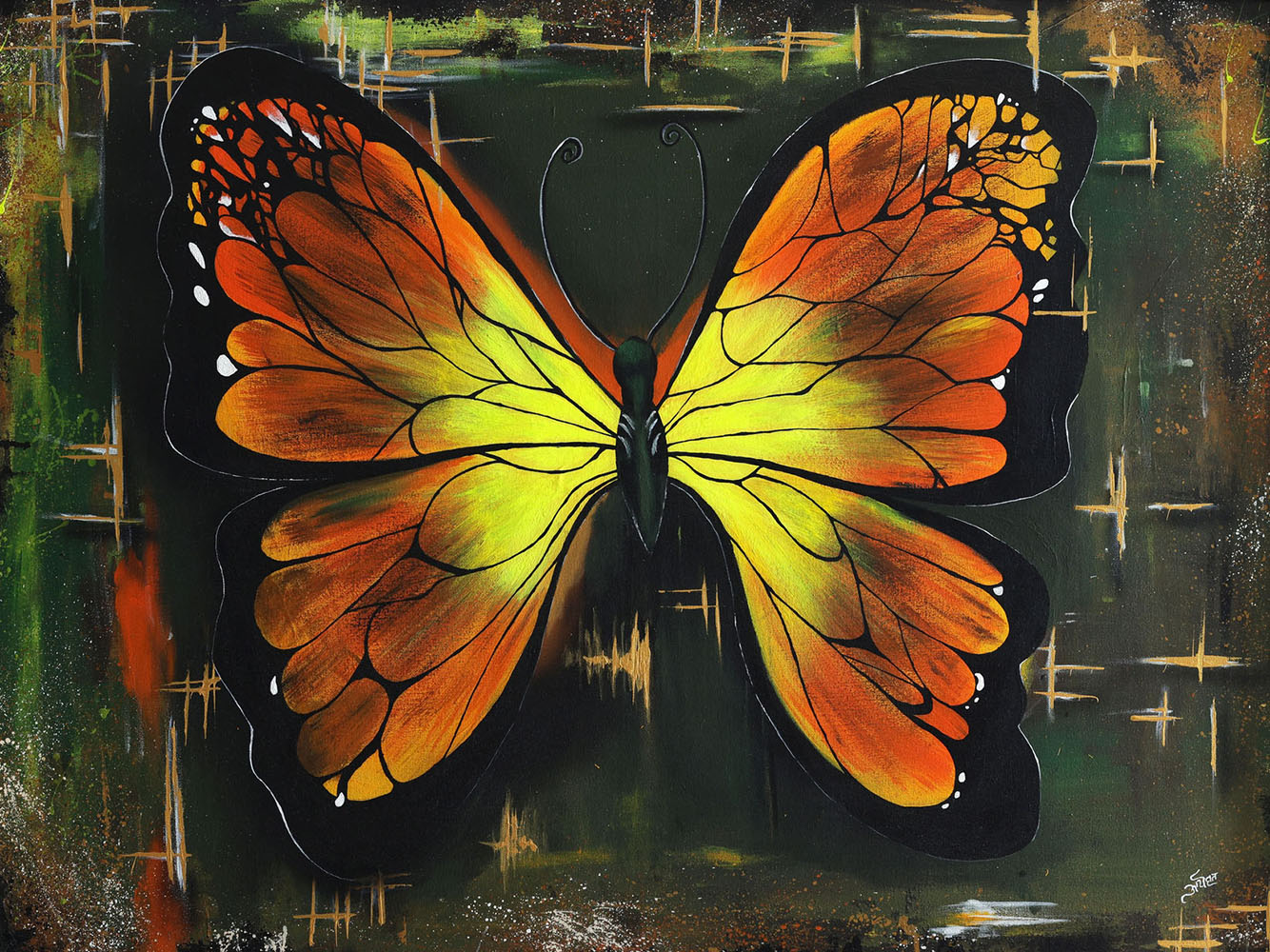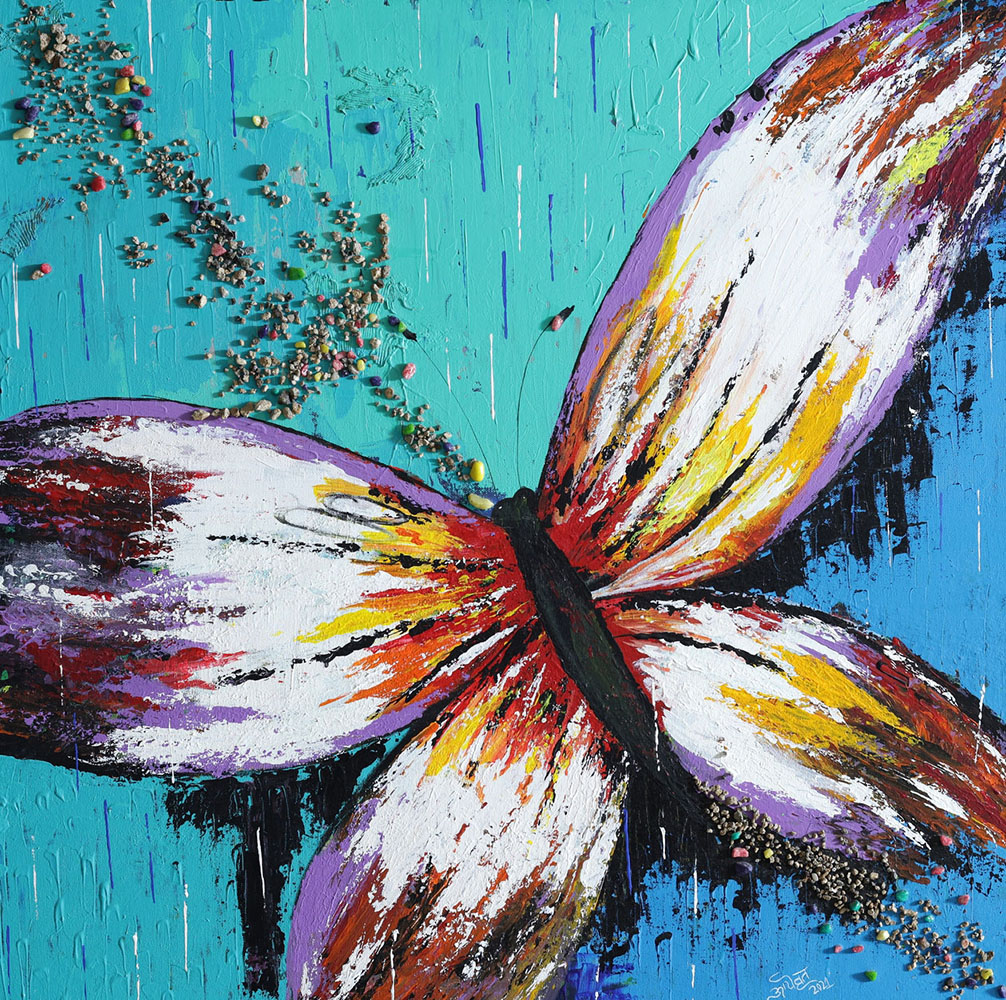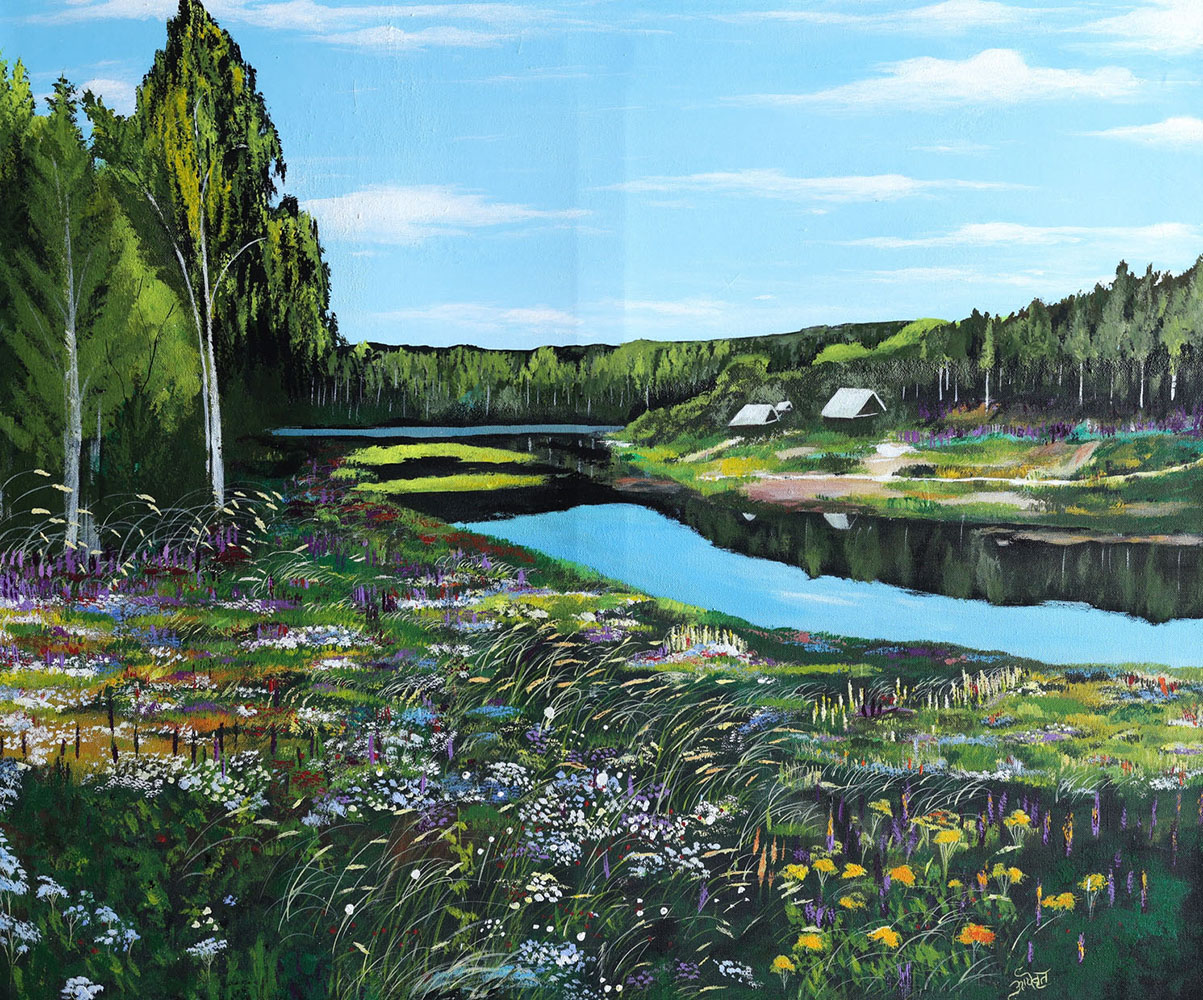Stillness by the Lake
Acrylic on Canvas (assumed — please adjust if needed)
This peaceful landscape painting captures a quiet, contemplative moment in nature. Dominated by a grand, leafy tree in the foreground, the composition opens to reveal a serene lake reflecting the vivid blues of the sky and the dense green forest lining its shores. The framing of the tree, foliage, and path draws the viewer's gaze toward the shimmering water, creating a natural sense of depth and perspective. Purple wildflowers and ferns decorate the forest floor, bringing life and color to the shaded area beneath the tree. The light peeking through the canopy gently highlights the textures of the tree bark and the softness of the forest undergrowth. The mirrored water, still and glassy, conveys a sense of tranquility and timelessness. Show More
Artistic Intent:
This painting is a tribute to the untouched beauty of natural spaces. It evokes solitude,
introspection, and the restorative power of nature. The composition invites the viewer to
step into the scene and pause for a moment of stillness. It speaks to our quiet connection
with the environment and offers a peaceful visual escape.
Techniques Used:
- Rich layering to build forest density and tree foliage
- Light and shadow contrasts for depth and realism
- Smooth blending for water reflection and sky gradient
- Controlled brushwork for fine detail in wildflowers and ground cover
Tears of Reflection
Graphite on Paper
This hyperrealistic pencil sketch captures the raw emotion of a face drenched in water and tears. The artist demonstrates exceptional skill in rendering light, shadow, and texture. The water droplets are drawn with meticulous attention to transparency, refraction, and surface tension, creating a lifelike, almost photographic quality.
The teardrops and water running down the subject’s face evoke themes of vulnerability, sorrow, and resilience. The glistening highlights and subtle tonal gradients showcase the artist’s mastery over graphite, making each droplet appear threedimensional. The portrait invites the viewer into an intimate emotional experience, blurring the line between realism and emotional expression.
Krishna and the Dove of Peace
Acrylic on canvas
This artwork presents a modern spiritual interpretation of Lord Krishna, depicted with a striking blue complexion, adorned in a regal orange turban with a peacock feather—a traditional symbol of his divine identity. His expression is serene, introspective, and timeless.
At the center of the composition is a white dove, captured mid-flight, symbolizing peace, purity, and transcendence. Behind them, the detailed golden chakra (wheel) —reminiscent of the Dharma Chakra or Sudarshan Chakra—creates a powerful spiritual backdrop, linking the themes of cosmic order, righteousness, and time. The juxtaposition of deep black, vibrant orange, radiant gold, and calming blue creates a balance between spirituality, divinity, and universal harmony. The detailed jewelry and attire reference classical Indian aesthetics, while the overall composition maintains a contemporary, narrative-driven style. Show More
The use of light is masterful: warm sunlight highlights the path and the dresses of the women, creating a golden glow that evokes a peaceful late afternoon. The sky, painted with gentle streaks of white clouds against a deepening blue, enhances the tranquil yet slightly mysterious atmosphere.
Artistic Highlights:
Strong use of symbolism (Krishna, peacock feather, dove, chakra)
Balance of traditional Indian and modern art elements
Bold color contrasts enhancing depth and spiritual tone
Detailed rendering of facial expression and ornamentation
Themes:
- Peace and spiritual transcendence
- Divinity and cosmic balance
- Harmony between tradition and modernity
Gautam Buddha
Acrylic on Canvas
Inner Light is a serene and powerful portrayal of Lord Buddha, rendered in an expressive blend of cool blues, vibrant yellows, and deep blacks. This piece explores the theme of spiritual tranquility and enlightenment, with the closed eyes symbolizing deep meditation and inner peace. The artist uses a bold color palette—a contrast between cool, shadowy blues and warm, radiant yellows—to represent the journey from ignorance to awakening. The textures and brushstrokes, especially around the face and head, lend a sense of movement and energy, as though the painting is breathing with calm stillness.
The minimalistic yet impactful background helps keep the viewer’s focus on the face of the Buddha, whose peaceful expression exudes compassion and mindfulness. The golden tones flowing from the right suggest the light of wisdom or nirvana, emerging from the inner self. Show More
Artistic Highlights:
Strong symbolic use of color and light
Expressive, textured brushwork
Harmonious composition emphasizing facial serenity
Contrast between darkness and light to signify transformation
Stylized form combining realism and abstraction
Themes:
- Enlightenment and meditation
- Inner peace and mindfulness
- Transformation through spiritual awakening
- The divine within the ordinary
- Energy through simplicity
Divine Harmony
Acrylic on Canvas (adjust if needed)
Divine Harmony is a symbolic and spiritual composition that blends abstract form with cultural iconography. At the center is a faceless feminine figure holding a traditional Indian musical instrument, possibly a tanpura, seated beside a serene white cow adorned with a red tilak—both deeply embedded symbols of Indian spirituality and pastoral purity.
The faceless figure, rendered in smooth curves and warm tones, suggests the universal divine feminine rather than a singular identity. The dripping brushstrokes and layered textures lend the piece a mystical, dreamlike quality—blurring the boundaries between the real and the sacred. Show More
Color & Composition:
The composition is balanced with bold blocks of mustard yellow, white, deep red, and black. The
contrast between sharp geometric spaces and organic forms draws the viewer’s eye from the figure
to the cow, and back to the instrument. The golden tones evoke divinity and tradition, while the
expressive strokes create movement and emotion.
Symbolism & Interpretation:
Cow: Symbol of peace, devotion, and abundance in Indian culture.
Faceless Figure: Represents the divine mother, art, or the universal soul.
Tanpura: A metaphor for the eternal hum of the universe, music as spiritual practice.
Abstract Background: Suggests the chaos of the external world, in contrast to the internal serenity of
the subject.
Mood & Themes:
Tranquil, meditative, and reverent. The piece reflects the harmony between humanity, nature, and
spiritual practice.
Techniques Used:
- Acrylic layering for depth and tonal variation
- Controlled dripping and blending to suggest transcendence
- Minimalist facial detailing to enhance universality
Shattered Grace
Acrylic on canvas
Shattered Grace presents a powerful visual metaphor of inner strength and emotional complexity. The central figure—a woman painted in grayscale—emerges from a fractured, crystal-like backdrop composed of geometric shards in hues of blue, gray, and gold. Her expression is calm and introspective, her posture elegant yet detached, as if rising from or dissolving into a state of fragmented reality.
The artwork combines realistic portraiture with abstract, cubist-inspired geometry, symbolizing the multifaceted layers of identity and consciousness. The bold, dripping textures of gold and copper introduce a tactile element of raw vulnerability and transformation. Show More
The interplay of soft and hard forms—fluid curves against sharp angular fragments— reflects the delicate balance between beauty and chaos, creation and destruction. The palette, though limited, is rich in emotion, giving the piece a sense of mystery, elegance, and depth.
Artistic Highlights:
Grayscale figure contrasting a vibrant, fractured background
Abstract geometric layering suggesting emotional or psychological fragmentation
Expressive hand gestures evoking communication and expression
Bold use of negative space and metallic highlights for texture and contrast
Themes:
- Identity and transformation
- Emotional resilience
- The interplay between inner self and outer world
- Feminine strength and introspection
Duality Within
Acrylic on Canvas (adjust if needed)
Duality Within is a compelling cubist-inspired composition that explores the complexities of identity, emotion, and inner contradiction. The painting features two overlapping faces—stylized, abstract, and vividly colored—symbolizing the multifaceted nature of human consciousness. The central figure, with closed eyes, conveys introspection and inner peace, while the secondary profile, with its gaze directed outward, suggests awareness and confrontation with the external world. Show More
Color & Composition:
The artist employs a striking color palette of turquoise, crimson, ochre, and electric
orange to create contrast and emotion. Geometric fragmentation and clean lines define
the contours of the faces, clothing, and background, creating a rhythmic tension between
chaos and control. The use of bold outlines, symmetry, and color blocking gives the piece
a powerful sense of structure despite its abstract nature.
Symbolism & Interpretation:
Two Faces: Represent the inner self and the outward persona, the conflict or harmony
between thought and action.
Eyes Closed/Open: A dialogue between introspection and external awareness.
Contrasting Colors: Express emotional duality—passion vs. calm, reason vs. instinct.
Geometric Elements: Suggest architectural influences and the calculated layers of
personality.
Mood & Themes:
Bold, introspective, and psychologically rich, this painting delves into themes of identity,
duality, and emotional complexity. It invites viewers to reflect on the masks they wear
and the self they conceal or reveal.
Techniques Used:
- Cubist construction with modern color sensibility
- Heavy acrylic layering and palette knife work
- Strong use of negative space and contrasting textures
Mountain Chapel in a Forest Clearing
Acrylic on Canvas (assumed based on texture and finish—adjust if different)
This vibrant and atmospheric painting captures a serene moment in a mountainous forest landscape, centered around an old stone chapel perched atop a rugged hill. The architecture is romantic and slightly Gothic, with arched windows and a cylindrical bell tower. Warm earthy tones dominate the foreground, contrasting beautifully with the cool blues of the sky and distant horizon.
The composition guides the viewer’s eye from the winding rocky path in the foreground, past a group of villagers in traditional dress, up to the chapel’s grand wooden doors. The figures add a narrative element—perhaps they are arriving for a celebration, pilgrimage, or community gathering. The surrounding forest, with its tall pine trees and sun-dappled foliage, adds a sense of shelter and timelessness. Show More
The use of light is masterful: warm sunlight highlights the path and the dresses of the women, creating a golden glow that evokes a peaceful late afternoon. The sky, painted with gentle streaks of white clouds against a deepening blue, enhances the tranquil yet slightly mysterious atmosphere.
Artistic Intent:
The painting blends natural beauty with historical architecture to evoke a sense of nostalgia
and reverence. It invites contemplation on themes such as community, faith, and the quiet
strength of nature. The harmonious balance of color and composition creates a timeless
scene that feels both inviting and sacred.
Techniques Used:
- Layered brushwork for foliage and ground textures
- Subtle gradients in the sky to imply depth and weather changes
- Fine detailing on architectural elements to suggest age and history
- Warm vs. cool color contrasts to draw attention and create mood
Goddess Of Kerala
Acrylic on canvas
Ethereal Muse is a bold, modern representation of feminine grace and cultural identity through the lens of contemporary abstraction. The subject—a woman adorned with traditional ornaments and a turban—emerges from a kaleidoscope of colors that redefine realism with expressive freedom.
The face, composed of fragmented, overlapping color blocks in aqua, teal, crimson, lavender, and mint, reflects a convergence of inner emotion and outer expression. Her confident gaze draws the viewer in, commanding attention and evoking a sense of timeless wisdom. The red forehead bindi becomes a central point, grounding the fluidity of the composition with symbolic depth. Show More
Set against a dramatic backdrop of fiery reds, oranges, and blacks, the figure’s presence is both serene and powerful—like a deity emerging from the flames of transformation. The painterly strokes around the edges add texture and motion, creating contrast with the flat, smooth application within the subject.
Themes
- Female divinity and strength
- Cultural expression through modern aesthetics
- Transformation, identity, and power
- Beauty in abstraction
Divine Elegance
Mixed Media on Canvas
Divine Elegance is a mesmerizing portrayal of a woman who radiates power, mystery, and cultural richness. The figure is adorned with ornate jewelry, flowing henna-like motifs, and a vibrant sari-inspired garment, all of which capture the essence of traditional South Asian femininity and grace.
What immediately draws the eye are the gilded earrings and necklace, which seem almost tangible due to their textured, golden rendering. The stylized red-and-blue facial markings and abstractly detailed hair evoke a sense of spiritual symbolism—suggesting that this is more than just a woman, but a divine or mythological figure. Show More
The presence of two bright orange birds, perhaps parrots, perched atop her head adds an element of mysticism and storytelling. They seem to whisper secrets from a realm beyond the canvas, deepening the narrative layer of the painting. Her serene yet powerful expression, emphasized by cool tones of teal and blue on her lips and eyelids, suggests wisdom and quiet strength.Fusion of figurative and abstract styles Rich use of cultural elements and symbolism Tactile texture in jewelry and garment details Dynamic contrast between warm and cool tones Intricate henna-inspired hand design
Themes:
- Cultural pride and feminine strength
- Spiritual symbolism and divine beauty
- Ornamental storytelling through color and form
- Fusion of tradition with modern abstraction
Harmony in Geometry and Nature
Acrylic on Canvas
This painting is a striking diptych composed of two visually connected panels. The left side showcases a vivid geometric village, built with angular rooftops and boldly colored houses in shades of red, blue, pink, and yellow. These structured shapes create a rhythmic harmony, symbolizing community and everyday life.
On the right, a stylized female figure emerges in warm earthy tones, contrasted by a deep green background. She is depicted in profile, exuding calmness and grace, with her hand resting near a majestic turquoise bird—possibly a swan—whose neck elegantly curves to form a gentle connection with her heart. The bird may symbolize purity, peace, or spiritual awakening. Show More
Artistic Elements:
Color Palette: Bold, saturated hues (greens, reds, blues) convey energy and cultural
vibrancy.
Lines & Shapes: Sharp geometric forms juxtapose with soft curves of the figure and
bird, enhancing visual tension and balance.
Texture: Visible brush textures and layering add depth and movement, especially in the
background detailing.
Concept/Message:
The piece appears to explore the coexistence of humanity, nature, and structured life.
The woman and bird represent emotional and spiritual elements, while the village on
the left reflects societal structure. The unified color tones across both panels suggest
interconnection.
Techniques Used:
Use of flat color planes and sharp geometric shapes for spatial abstraction
Layered textures (dots, circular prints, drips) for visual rhythm and depth
Smooth, stylized human form to contrast with rigid village architecture
Complementary colors (green-red, orange-blue) to energize the composition
Show Less
Meditative Shiva
Ink and acrylic on canvas
Meditative Shiva is a powerful monochromatic artwork capturing the divine stillness and inner strength of Lord Shiva in deep meditation. The artist uses black and grey ink with splashes of white, contrasted with a single red dot on the forehead, drawing immediate attention to the third eye—a symbol of spiritual wisdom and destruction of evil.
The bold brushwork and expressive ink splatters enhance the raw energy and mysticism of the subject. Iconic features such as the crescent moon, trident mark (Trishul) on the forehead, Rudraksha beads, and tied jata (hair knot) convey Shiva’s traditional attributes, while the abstract style introduces a modern artistic interpretation. Show More
This piece beautifully combines spirituality with contemporary aesthetics, offering viewers a moment of introspection and divine presence.
Artistic Highlights:
Use of high-contrast black and white tones
Symbolic detailing (Trishul, crescent moon, Rudraksha, third eye)
Expressionist ink-splatter technique
Strong emotional and spiritual presence
Themes:
- Divinity and meditation
- Balance of chaos and calm
- Traditional Indian symbolism in modern art style
Lord Ganesha
Mixed Media on Canvas
This painting is a bold and contemporary spiritual composition that intertwines symbolic elements from Hindu mythology—namely Lord Ganesha, the Shiva Lingam, and the Trishul (trident). Rendered in an expressive abstract style, the artwork uses rich, textured layers of paint to convey depth and movement. The left side prominently features a partial face of Lord Ganesha, characterized by his iconic curved trunk and single expressive eye, symbolizing wisdom and new beginnings. A vivid red splash at the forehead marks the sacred tilak, signifying divine energy. The dynamic strokes of orange, gold, and white further enhance the spiritual vibrancy of the piece. Show More
To the right, the Shiva Lingam—symbol of Lord Shiva's infinite cosmic power—is depicted in deep black, accented by horizontal white lines and a red mark, denoting sacred ash and spiritual awakening. The trident (Trishul), another emblem of Lord Shiva, emerges behind the Lingam in bold, distressed strokes of black and gold, reinforcing the themes of destruction and renewal.
The painting blurs the lines between realism and abstraction, symbolizing the transcendental nature of divinity that goes beyond form. The interplay of colors and textures invites the viewer to a meditative reflection on balance, duality, and the infinite cycle of creation and dissolution.
Themes:
- Spirituality
- Hindu symbolism
- Abstract expressionism
- Unity of divine forces
Techniques Used:
- Palette knife texture Acrylic layering
- Splatter and drip effects Gold leaf accents
Duality of Ganesha
Acrylic on Canvas
Duality of Ganesha is a captivating interpretation of Lord Ganesha that explores the contrast between tradition and abstraction, color and monochrome, material and divine. The canvas is divided visually and symbolically: the left half of Ganesha's face is painted in a vivid spectrum of colors, representing creativity, joy, and life’s vibrancy, while the right half is rendered in grayscale, reflecting serenity, wisdom, and spiritual depth. At the top of the composition, vibrant orange and red brushwork suggest energy and cosmic power. The inclusion of the ‘ॐ’ (Om) symbol on the forehead and the Sanskrit verse from the Ganesh Vandana grounds the painting in spiritual tradition. Show More
Artistic Highlights:
Symbolic use of duality to represent material and spiritual worlds
Integration of sacred Sanskrit script enhances cultural depth
Rich texturing and bold contrast of colors evoke divine energy
Stylized depiction of Ganesha merges traditional iconography with modern art
Themes:
- Duality of existence (joy & peace, color & shadow)
- Harmony between material life and spiritual growth
- Indian mythology reimagined in contemporary form
- Blessings, protection, and removal of obstacles
Harmony of Emotions
Wool Embroidery on Mesh Canvas
This unique piece is crafted using vibrant wool threads on a mesh canvas, blending textile art with surreal portraiture. The expressive female face is surrounded by flowing fish, symbolizing emotion, thought, and the connection between the human spirit and nature. The use of wool creates rich texture and depth, enhancing the movement and fluidity within the composition. The dripping threads from the eyes and lips evoke feelings of vulnerability and introspection, making this artwork both visually captivating and emotionally resonant.
Fragmented Emotions
Acrylic on Canvas
This painting is a striking example of modern cubist-inspired abstract portraiture. The face of a woman is constructed through a fragmented composition of bold geometric shapes and vivid color blocks. Each section of the face is painted with different hues—ranging from warm yellows and reds to cool blues and greens—symbolizing the multifaceted nature of human emotion and identity.It's an abstract portrait of a woman using bold colors and geometric shapes. Show More
The artwork is a part of a collection that explores different facets of being, often portraying strong-minded women The artist skillfully balances abstraction with emotional depth, drawing the viewer in through expressive eyes that contrast sharply with the angular, deconstructed facial planes. The textured background, rich in layered color and movement, enhances the painting’s dynamism and energy.
This work speaks to themes of inner complexity, identity, and transformation, making it both visually compelling and emotionally resonant. It demonstrates strong control of color theory, composition, and expressive brushwork Show Less
Fury in Flight
Acrylic on Canvas (adjust as needed)
This electrifying painting captures a bald eagle mid-dive, rendered against a bold crimson background. The eagle's wings explode with dynamic brushstrokes and splashes of saturated color—blues, purples, and iridescent greens—punctuated by streaks of white that give the sense of intense speed and power. The fierce gaze and curved beak of the bird contrast sharply with the wild abstraction of its feathers, symbolizing both primal instinct and focused precision. The textured red backdrop enhances the dramatic impact, serving as a visual metaphor for courage, aggression, and vitality. The talons, outstretched and highlighted in vibrant yellows, appear to be moments away from contact—embodying action frozen in time. Show More
Artistic Intent:
This work explores themes of strength, freedom, and untamed force. The bald eagle—a universal
symbol of power and sovereignty—is not portrayed passively, but in full predatory motion. The
use of splatter and gestural strokes intentionally breaks away from realism, expressing the raw
energy and chaos of nature.
Techniques Used:
Impasto and palette knife work for texture
Spontaneous splatter and dynamic brushstrokes for motion
High-contrast composition with a limited, bold color palette (red, black, white, yellow, and
electric hues)
Textural layering to create a visceral impact
Show Less
Watcher in the Shadows
Oil colour on canvas
Watcher in the Shadows captures the commanding presence of an owl perched silently on a branch, its fiery orange eyes glowing with intensity against a textured, abstract background. Painted in bold strokes of yellow, green, black, and white, the owl becomes a beacon of wisdom and mystery in the darkness. The background blends organic textures and vibrant splashes of color—blue, violet, and ochre—suggesting a mystical forest or dreamscape.
The piece is defined by expressive, almost chaotic brushwork and a moody atmosphere. Jagged strokes above the owl’s head resemble stalactites or dripping shadows, heightening the tension and mystery. The reflection of the owl below subtly suggests a duality—what is seen vs. what is hidden. Show More
Artistic Highlights:
Use of contrast to create mood and focus
Vivid, expressive brushstrokes and texture
Symbolism of the owl (wisdom, guardianship, mystery)
Surreal reflection effect and atmospheric depth
Themes:
- Nocturnal awareness
- The unseen observer
- Nature’s mysticism in a surreal setting
Greed in Gold
Oil colour and Texture Medium on Canvas
Greed in Gold is a bold and satirical work that blends pop culture with fine art technique. The painting features a reimagined version of the iconic cartoon figure Scrooge McDuck, presented in rich, golden tones with textured, gilded embellishments. The character is seen admiring a heart-shaped object encased in glass, with the Indian Rupee symbol (₹) etched onto it—an evocative representation of the conflation between love and material wealth.
Concept & Symbolism:
This piece humorously critiques the obsession with money, consumerism, and how wealth is
often idolized or protected like a precious emotion (symbolized by the glass-encased heart).
The Rupee symbol on the heart speaks to cultural specificity, grounding the work in an Indian
socio-economic context.
Show More
The character’s classic cartoon innocence is juxtaposed with modern elements like the luxury watch, reflecting a commentary on changing values across generations. Mood & Interpretation:
At first glance, the painting feels lighthearted and nostalgic. But upon deeper reflection, it reveals a poignant critique of modern materialism. The heart, usually a symbol of vulnerability and emotional depth, is now locked behind glass and branded with currency—asking: What is the cost of love in a world obsessed with wealth?
Techniques Used:
- Mixed media with heavy texture and metallic acrylics
- Stylized character illustration with bold outlines and expressive shading
- Dripping gold paint for visual richness and symbolic decay
Radiance in Flight
Acrylic on canvas
Radiance in Flight showcases a brilliantly rendered butterfly, centered boldly against a textured, abstract background. Its wings, painted in vibrant gradients of yellow, orange, and amber, convey a sense of transformation and energy. The deep black borders of the wings enhance the contrast, adding definition and elegance to the organic form.
The background is a dynamic mix of earthy greens, burnt oranges, and subtle sparkles, with linear cross-hatch marks that evoke an abstract forest or twilight environment. The texture and color layering create depth, allowing the butterfly to appear almost three-dimensional. Show More
Symbolically, the butterfly represents metamorphosis, hope, and spiritual evolution. The glowing palette and balanced composition highlight themes of rebirth and inner light, making this artwork both striking and uplifting.
Artistic Highlights:
Bold use of complementary colors to emphasize form and energy
Smooth blending for a glowing, illuminated effect
Abstract background with textural contrast and spatial depth
Centered composition with symmetrical elegance
Themes:
- Transformation and personal growth
- Nature’s delicate beauty
- Spiritual and emotional awakening
Painting of a Butterfly
Mixed media on canvas (acrylic paint, palette knife texture, and decorative stones/beads)
Flight of Color is a dynamic and expressive piece capturing the motion and vibrancy of a butterfly in flight. The butterfly, painted with bold strokes of red, orange, yellow, purple, and white, symbolizes transformation and freedom. The use of a palette knife gives the wings a richly textured appearance, adding energy and depth. The background—a blend of turquoise and blue hues—creates contrast and emphasizes the butterfly’s vibrant colors. Embellished with decorative elements like small stones and beads, the piece breaks into three-dimensional space, enhancing its visual interest and tactile appeal. Show More
This artwork combines abstraction and realism, evoking themes of metamorphosis, freedom, and nature’s chaotic beauty. It demonstrates proficiency in layering, color theory, and mixed-media techniques.
Themes:
- Texture and layering
- Bold color contrasts
- Symbolism of transformation
- Use of mixed media for tactile dimension
Spirit of the Forest
Acrylic and Texture Medium on Canvas (update if necessary)
Spirit of the Forest is a striking, semi-abstract representation of a deer, imbued with symbolic mysticism and raw visual texture. The majestic creature emerges from an ethereal forest backdrop, rendered in deep blues and vibrant golds. The stag, with its glowing antlers and piercing eyes, appears as a guardian of nature—silent, still, yet full of ancient power.
Color & Technique:
The color palette is rich and emotive:
Icy blues and cool whites create the deer’s form, suggesting purity, calm, and a connection to the spiritual
realm.
Show More
Emerald greens and shadowy indigos construct the forest-like background, evoking depth and mystery. Striking orange and golden textures add contrast, warmth, and a sense of divine energy flowing through the scene. The use of impasto technique—particularly around the frame edges—builds a tactile dimension, especially with the heavy golden accents. Brush drips and palette knife strokes enhance the abstract depth of the surroundings, blending realism with expressive abstraction.
Mood & Interpretation:
This painting exudes an almost meditative calm, yet carries an undercurrent of intensity. The deer does not
dominate the canvas aggressively—it emerges, watches, and waits. It reflects themes of inner stillness, the
quiet power of nature, and the unseen forces that inhabit wild spaces.
Techniques Used:
- Impasto and texture medium for dimensional gold accents
- Layered brushwork and vertical drips to create depth and movement
- Stylized abstraction for emotional expression
Whispers of a Wild Meadow
Acrylic on Canvas (please adjust if different)
This vibrant landscape painting captures the serene beauty of a countryside riverbank during peak bloom. A meandering stream of crystal-blue water flows through a lush meadow adorned with wildflowers of every shade—delicate whites, golden yellows, soft purples, and flashes of orange. The left foreground is rich with texture and color, creating a sensory immersion into nature’s raw and unstructured charm.
In the distance, two small cottages sit quietly beneath a dense forest edge, their grey rooftops barely interrupting the continuity of green. A thick band of trees frames the horizon, leading the viewer's gaze across the canvas from the wildflowers in the front to the darkened tree line at the back. The reflective surface of the water adds depth and tranquility to the scene, mirroring the calm blue sky scattered with thin clouds. Show More
Artistic Intent:
This painting is a visual ode to untouched natural landscapes—a celebration of simplicity,
silence, and seasonal bloom. It evokes a sense of rural solitude and gentle passage of time,
capturing a moment where the wild meets the stillness of water. It aims to remind viewers of
the peaceful sanctuaries that lie far from urban noise.
Techniques Used:
- Layered dry brushing and stippling for flower density and field texture
- Blending and soft gradients for sky and water reflection
- Sharp contrast between light foreground and dark forest edge for depth
- Natural, flowing composition leading from foreground flora to background architecture

